Weekly Arizona COVID-19 Data Report – Dr. Joe Gerald, July 16
Note this forecast page is not the most recent forecast available.
View the most current forecast report
Researcher Analyzes Arizona COVID-19 Spread Models for Decision-Makers
The following information regarding the spread of COVID-19 in Arizona was prepared by Joe Gerald, MD, PhD, a researcher at the Mel and Enid Zuckerman College of Public Health (MEZCOPH) at the University of Arizona. This information has also been reviewed by other MEZCOPH faculty.
This data were obtained from the Arizona Department of Health Services COVID-19 webpage and reflect conditions in Arizona as of July 16, 2021.
This information is intended to help guide our response to the outbreak. It is not intended to predict how this pandemic will evolve. Rather, this model extrapolates what might occur if current conditions remain unchanged. As regional authorities and healthcare providers respond, their actions are expected to mitigate the worst consequences of this pandemic.

COVID-19 Disease Outbreak Forecast
Arizona State and Pima County
Updated July 16, 2021
Disclaimer: This information represents my personal views and not those of The University of Arizona, the Zuckerman College of Public Health, or any other government entity. Any opinions, forecasts, or recommendations should be considered in conjunction with other corroborating and conflicting data. Updates can be accessed at https://publichealth.arizona.edu/news/2021/covid-19-forecast-model.
ALERT: Arizona experienced an unexpectedly large week-over-week increase in newly diagnosed cases and hospitalizations. Uncertainty surrounding total immunity levels makes it difficult to predict the potential duration and severity of this change in transmission rates. Policymakers and individuals should take immediate steps to adopt evidence-based mitigation practices to reduce transmission.
For the week ending July 11th, 5813 Arizonans were diagnosed with COVID-19, a 48% increase from last week’s initial tally of 3842 cases (Figure 1). This marks the 5th consecutive weekly increase and a brisk acceleration over past trends. The current rate, 80 cases per 100K residents per week, is increasing by 25 cases per 100K residents per week. For historical reference, the last time Arizona recorded this level of transmission on an upward trajectory was October 18, 2020 when 6330 cases were reported. While rates are twice as high among those 15 – 24 years of age as compared to those ≥65 years of age, 102 versus 45 cases per 100K residents per week, respectively, transmission is increasing among all age groups (Figure 2).
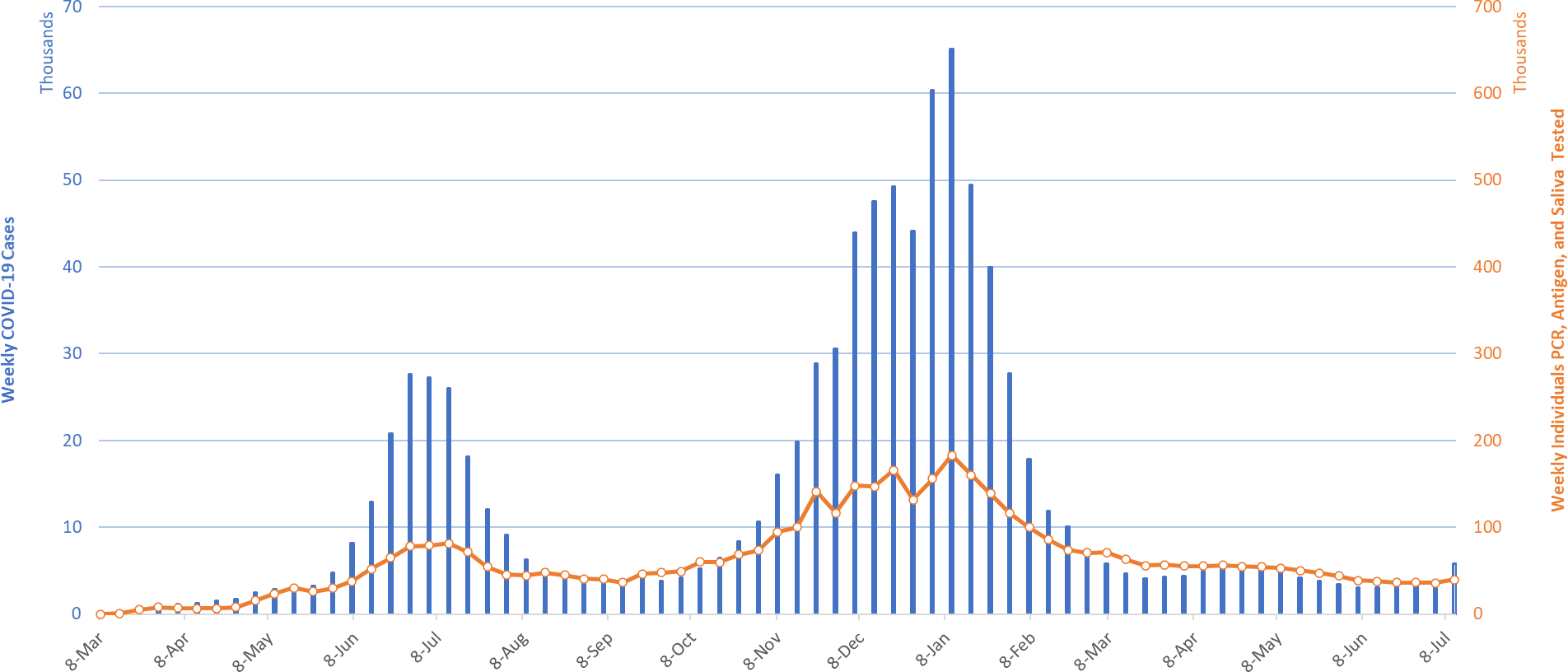
|
Figure 1. Newly Diagnosed Covid-19 Cases in Arizona and Number of Individuals Undergoing Covid-19 Diagnostic Testing March 1, 2020 through July 11, 2021. |
Unlike the last update which suggested slowly worsening conditions, this week’s change makes it likely that Arizona will soon experience cases rates >100 per 100K residents per week marking a transition from substantial to high levels of transmission. Prudence suggests we heed this warning and prepare for the worst even as we hope for the best.
According to the CDC, 55% of Arizona’s adult population is fully vaccinated and another 9% have received one dose. However, 12% of Arizona’s population has tested positive for COVID-19 disease making Arizona the state with the 6th highest level of natural immunity. However, considerable uncertainty remains about how many Arizonans were previously infected and how many of them also sought vaccination. If a large proportion of the previously infected sought vaccination, then total immunity may be considerably less than the simple sum of the two leaving us more vulnerable to another wave of infection than we might expect.
Note: Data for this report was updated Thursday, July 15.
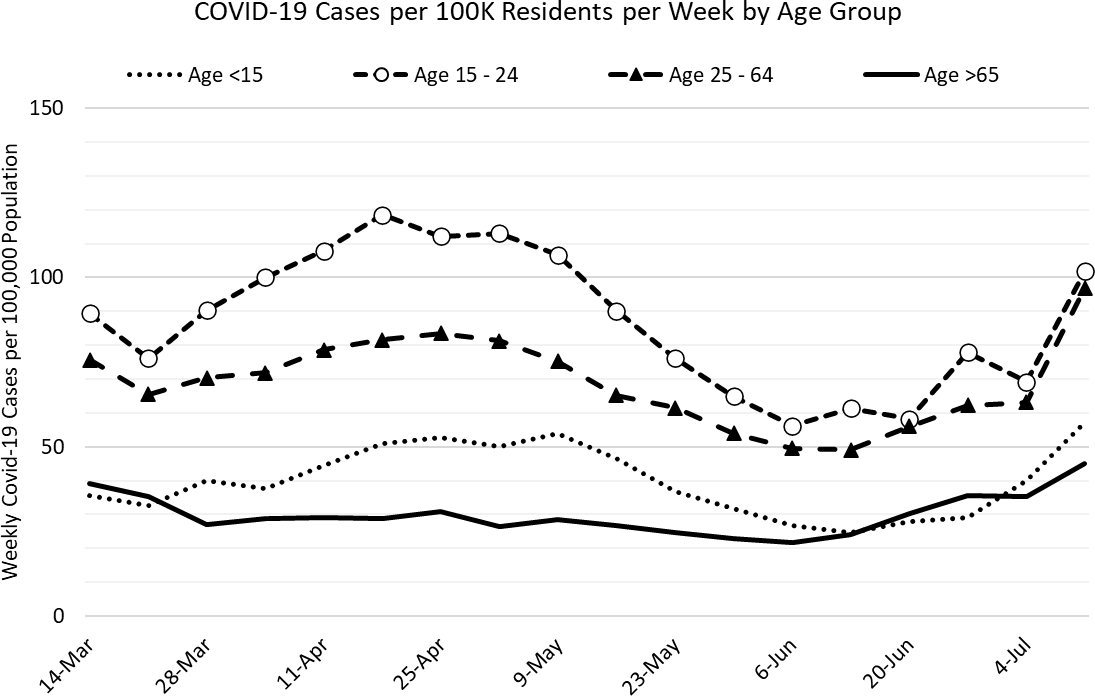
|
Figure 2. Newly Diagnosed Covid-19 Cases in Arizona by Age Group March 7 – July 11, 2021. |
Test positivity among those undergoing traditional nasopharyngeal PCR testing is 16%, much increased from last week’s 11%. This level indicates testing is inadequate for optimal public health practice with many cases likely going undiagnosed (Figure 3).
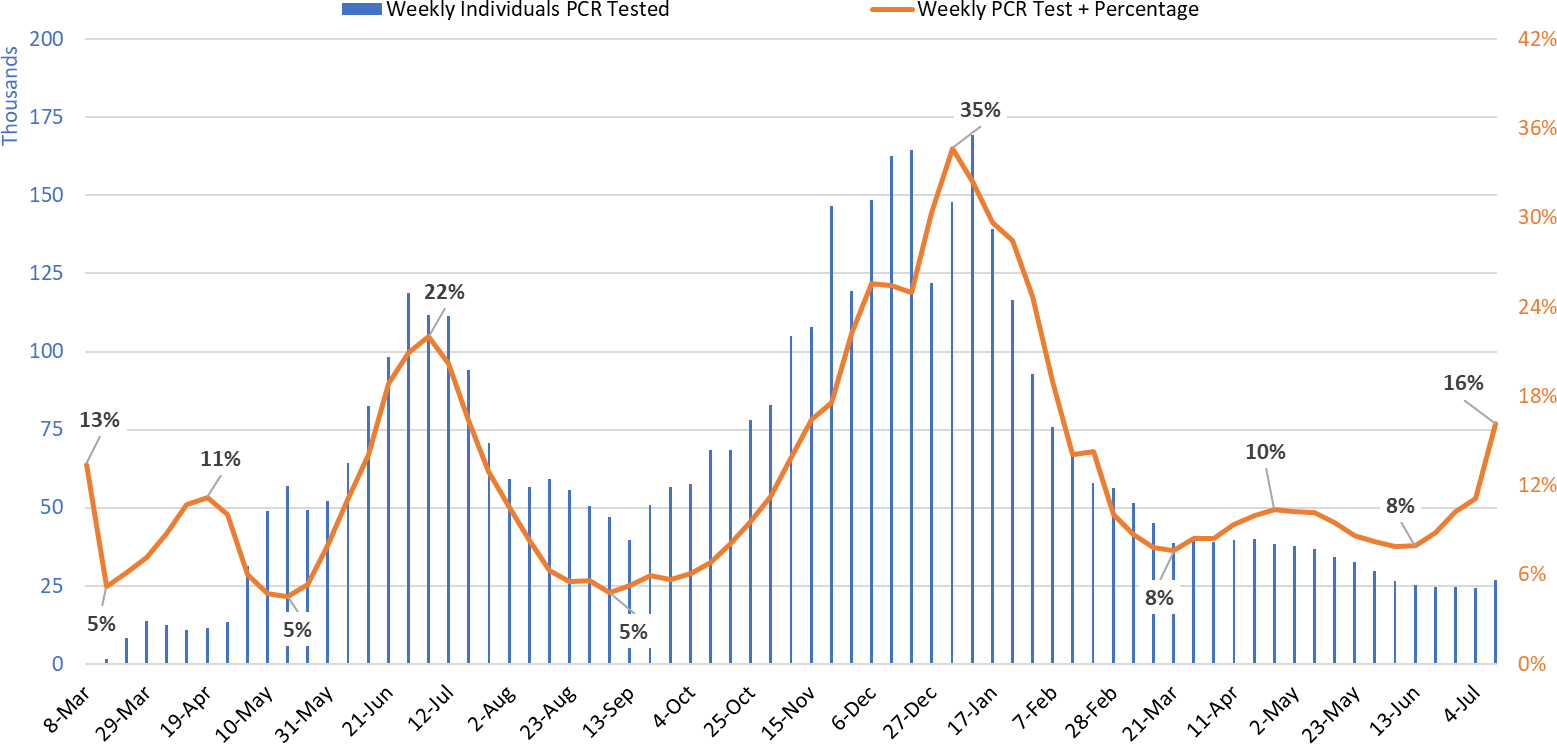
|
Figure 3. Weekly Number Patients Undergoing Traditional Nasopharyngeal PCR Testing and Associated Percent Positivity March 1, 2020 – July 11, 2021. |
As of July 14th, 689 (9%) of Arizona’s 8648 general ward beds were occupied by Covid-19 patients, a 26% increase from the previous week’s 548 occupied beds (Figure 4 and Figure 5 Panel A). Another 926 (11%) beds remained available for use. The number of available beds is lower than the previous week’s 1047 beds. The last time this many ward beds were occupied by COVID-19 was March 19, 2021 (n=700).
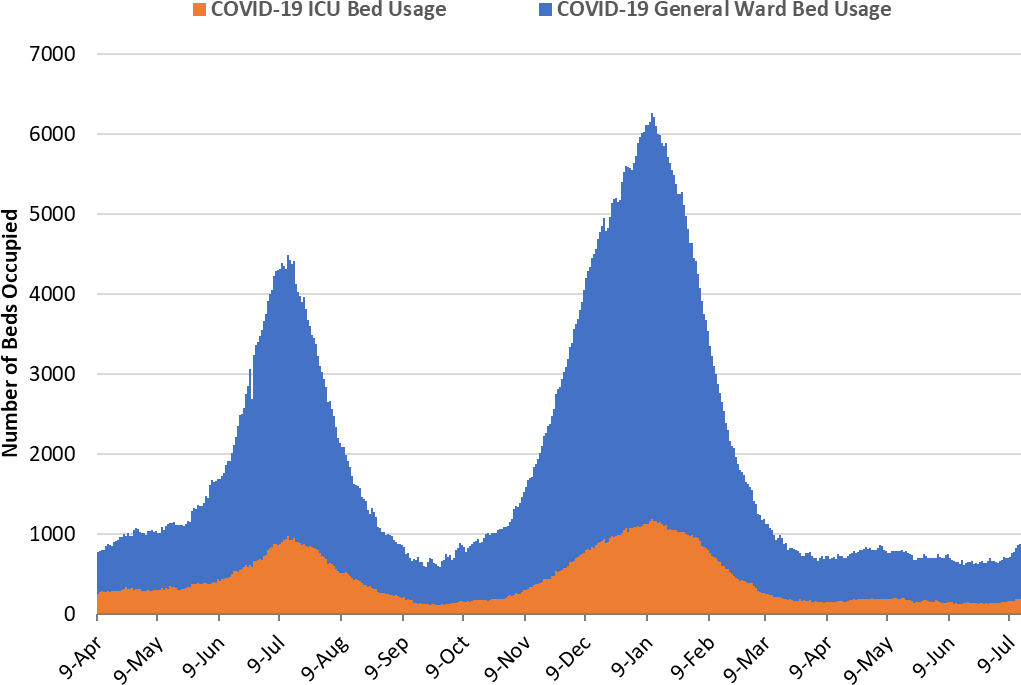
|
Figure 4. Arizona Daily Covid-19 General Ward and ICU Census April 9, 2020 – July 14, 2021. |
As of July 14th, 184 (12%) of Arizona’s 1737 ICU beds were occupied with Covid-19 patients, a 22% increase from the prior week’s count of 152 patients (Figure 4 and Figure 5 Panel B). An additional 218 (13%) ICU beds remained available for use. This is lower than the prior week’s 246 beds. The last time this many ICU beds was occupied by COVID-19 was March 18, 2021 (n=184).
|
Figure 5. Covid-19 Occupancy as a Percent of Listed General Ward (A, left) and ICU (B, right) Capacity in Arizona April 20, 2020 – July 14, 2021. |
Arizona hospital occupancy remains above seasonal levels. Improvements in ward and ICU occupancy remain stalled at ≥85% occupancy (Figure 6, following page). Undoubtedly, some medically necessary procedures that were previously postponed are still being rescheduled to address the backlog of care. Occupancy will need to fall 70-75% before conditions will be back to “normal.” However, hospitals should be prepared for >10% COVID-19 occupancy for the foreseeable future as viral transmission transitions from substantial to high levels.
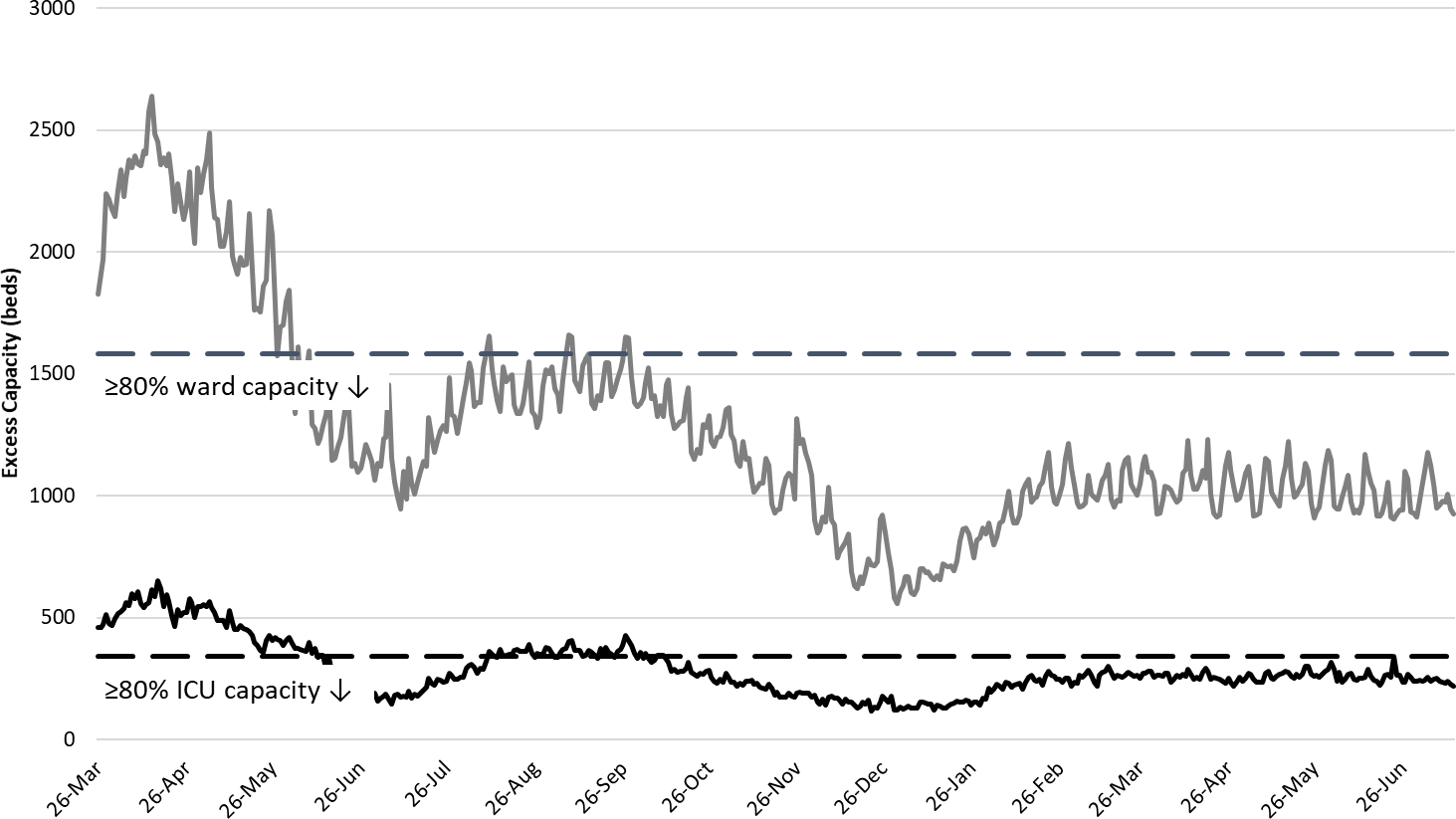
|
Figure 6. Observed Excess Non-Surge General Ward and ICU Capacity March 26, 2020 – July 14, 2021. |
The week ending January 17, 2021 remains Arizona’s deadliest with 1093 deaths (Figure 7). Arizona will continue to record 40 - 50 deaths per week for the next several weeks. Because there is a 21-day lag between cases and deaths, some time will need to pass before we know to what extent increased case rates will translate into more deaths.
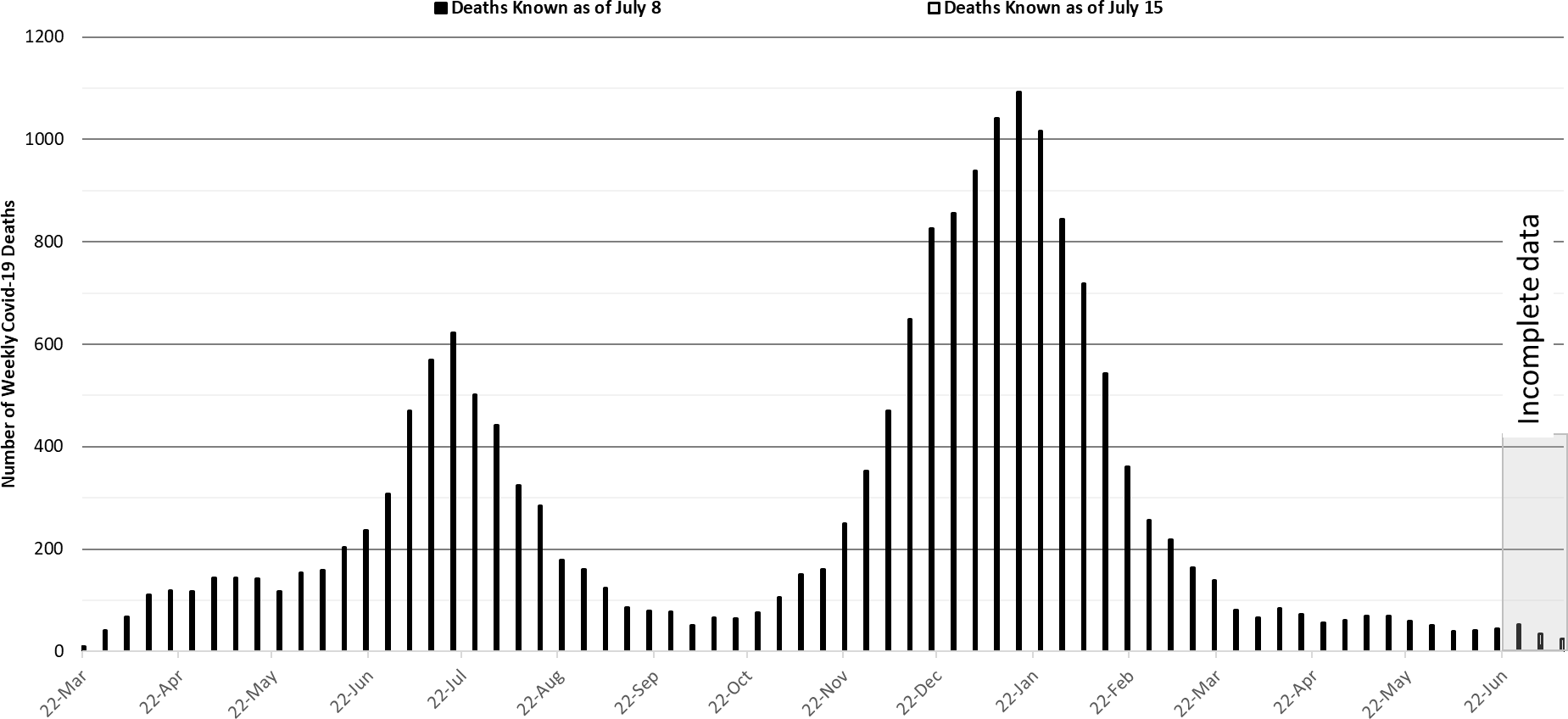
|
Figure 7. Weekly Arizona Covid-19 Deaths March 16, 2020 – July 11, 2021. |
Pima County Outlook
For the week ending July 4th, 423 Pima County residents were diagnosed with Covid-19 (Figure 8). This is a 26% increase from the 335 cases initially reported last week.
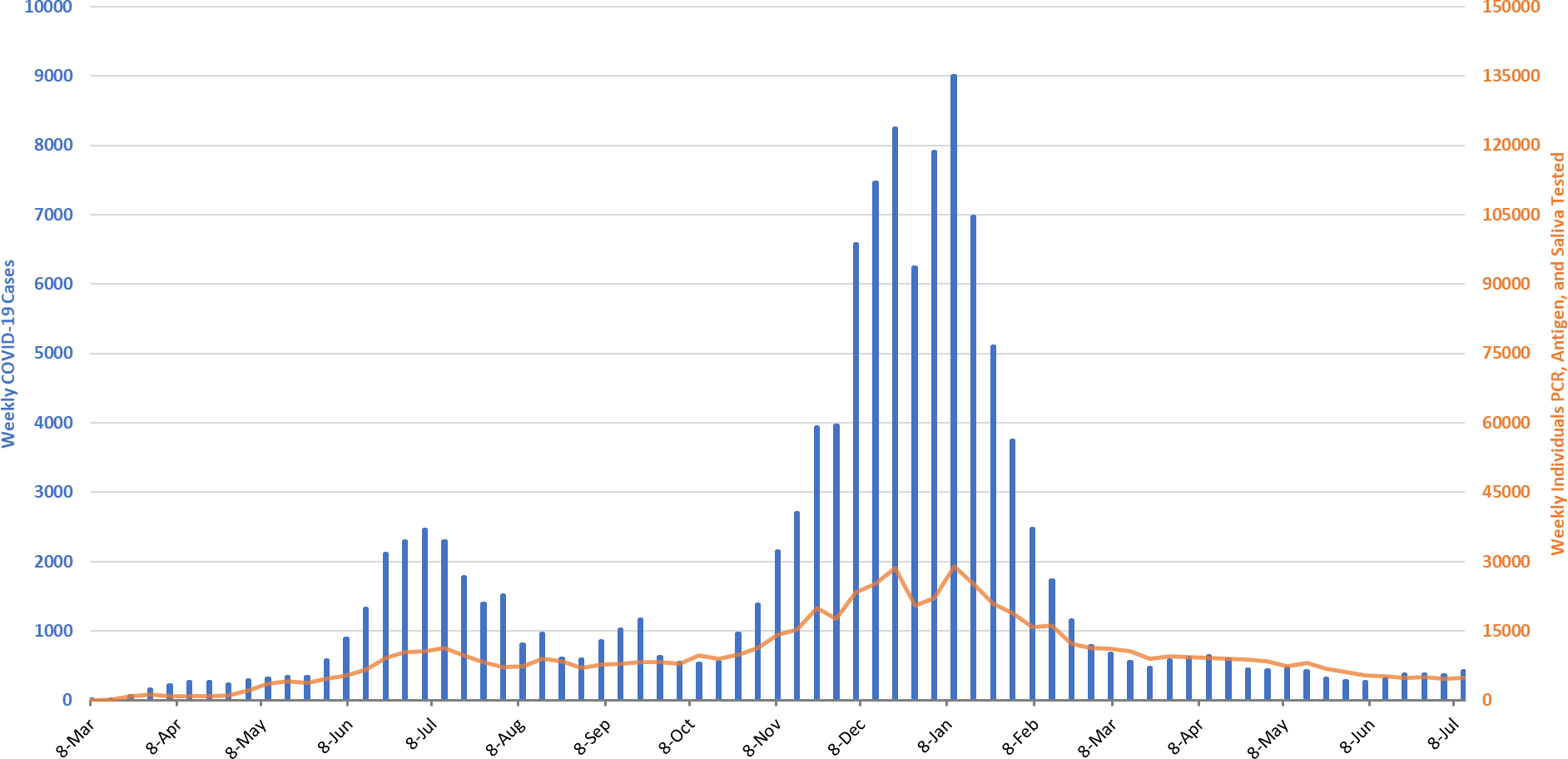
|
Figure 8. Covid-19 Cases and Individuals Undergoing Testing in Pima County Mar 1, 2020 – July 11, 2021 |
New cases are being diagnosed at a rate of 40 cases per 100K residents per week. Pima County’s rates remain lower than the state average and the week- over-week increase is also smaller. Trends across the various age groups appear in Figure 9.
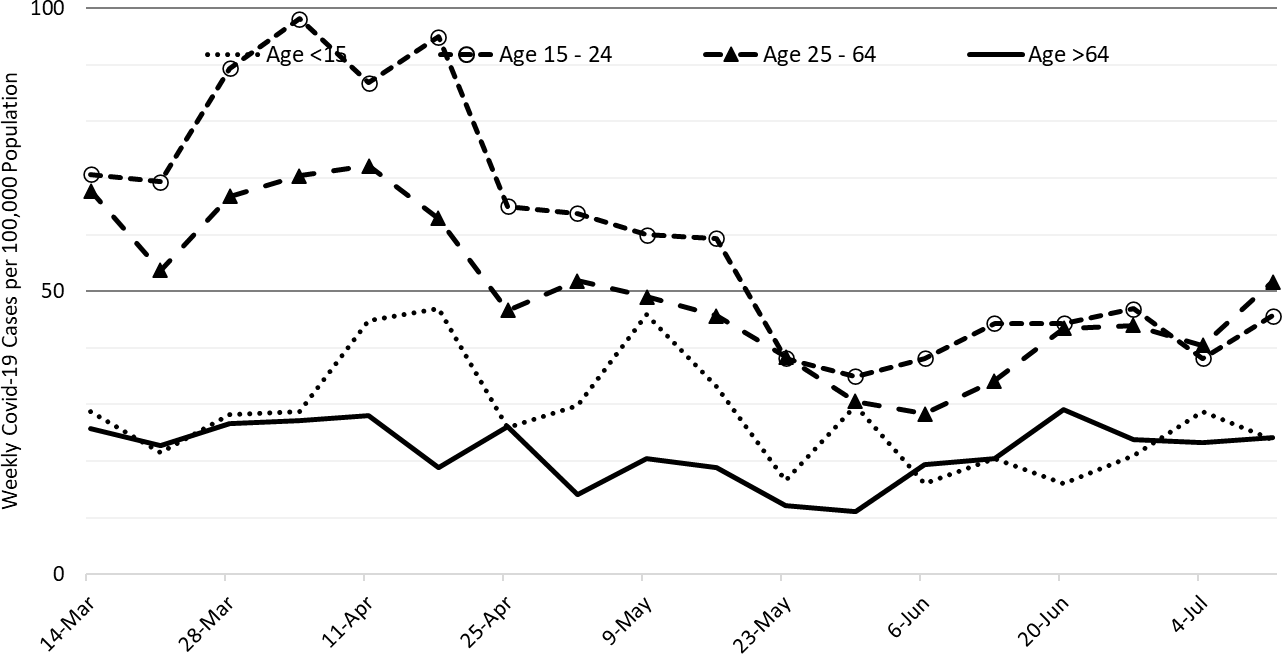
|
Figure 9. Covid-19 Cases by Age Group in Pima County from March 14 – July 11, 2021. |
Summary
- This past week saw a marked increase in viral transmission. If this increase is sustained, Arizona will quickly experience high levels of transmission that could lead to another surge of uncertain magnitude and duration. Unlike my previous assumption – roughly counterbalanced forces – it appears that total immunity is still insufficient to avert another surge in the presence of the more transmissible Delta variant.
- As of July 14th, new cases were being diagnosed at a rate of 80 cases per 100,000 residents per week. The rate is increasing markedly at >25 cases per 100,000 residents per week. Rt is meaningfully above 1 and may remain so for awhile.
- The emergence of another wave of cases and perhaps hospitalizations, depending on the age structure of the outbreak, seems more likely now than last week. The cause is likely attributable to increasing prevalence of the Delta variant. Unfortunately, reliable local sequencing data is sparse and lags conditions on the ground by several weeks.
- Considerable uncertainty regarding the possible magnitude and duration of the outbreak exists owing to inadequate data on the true past infection rate and the proportion of previously infected individuals who have also been vaccinated.
- Vaccination remains the most important public health priority to reduce viral transmission and severe illness.
- With this marked acceleration in transmission, mandating masks in indoor spaces and limiting large gatherings is warranted to reduce transmission in public settings.
- Unfortunately, it seems unlikely that state policymakers will take action to protect public safety, either by allowing vaccination mandates (e.g., school attendance), indoor mask mandates, or targeted business restrictions. Furthermore, individual action will not be able to stem the tide unless those most resistant to vaccination and mask-wearing change their behaviors.
- With inadequate vaccination uptake, eliminating COVID-19 is no longer a plausible public health policy goal. COVID-19 is almost certain to become an endemic disease with varying temporal and geographic implications. Fortunately, vaccination will remain a viable disease control strategy offering a high degree of protection to those willing to accept them.
- Hospital COVID-19 occupancy is increasing in the ward and ICU. COVID-19 occupancy is likely to exceed 10% of all beds for at least several weeks. Access to care remains somewhat restricted as overall occupancy remains unseasonably high at 85%.
- Arizona Covid-19 fatality counts are now 50 deaths per week. If cases continue to increase, then this number may be driven higher depending on transmission among those 65+ years of age.
- According to the CDC, 55% of Arizona adults have received at least 2-doses of vaccine while another 9% have received 1-dose. Arizona passed peak vaccination rates in early April and these rates continue to erode. We are unlikely to achieve 70+% vaccination of our eligible population and should be prepared to adjust to COVID-19 as persistent risk.
- Despite evidence of limited immune escape to the Delta variant, especially before completion of the full vaccination sequence, vaccination continues to provide extraordinarily high levels of protection from infection and severe illness.
Forecast reports to date, available as PDFs
Download PDF to view additional charts of Arizona counties, available in appendix of report.
2020 Reports
Based on what we know now about this pandemic, we support guidelines for social distancing to slow the spread of the virus and urge everyone to follow the recommendations provided by the Centers for Disease Control and Prevention (CDC) to protect yourself, your family, your neighbors, and your employees. Please heed the recommendations as provided by the CDC.
COVID covid coronavirus virus covid19 corona forecast model

